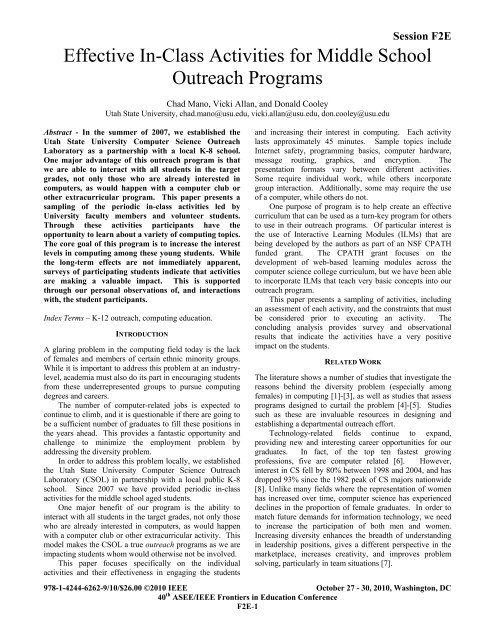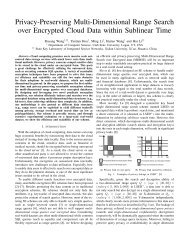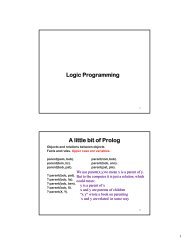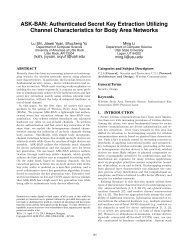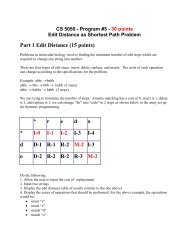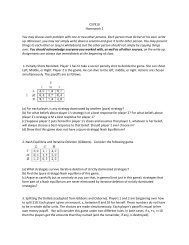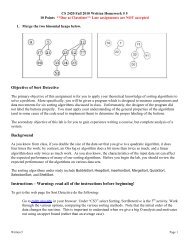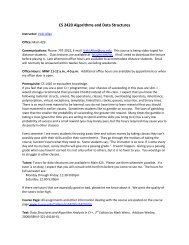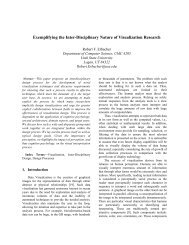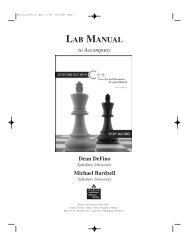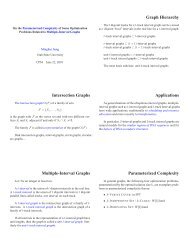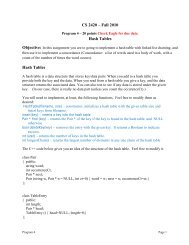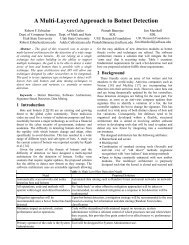Effective In-Class Activities for Middle School Outreach Programs
Effective In-Class Activities for Middle School Outreach Programs
Effective In-Class Activities for Middle School Outreach Programs
Create successful ePaper yourself
Turn your PDF publications into a flip-book with our unique Google optimized e-Paper software.
Session F2E<br />
<strong>Effective</strong> <strong>In</strong>-<strong>Class</strong> <strong>Activities</strong> <strong>for</strong> <strong>Middle</strong> <strong>School</strong><br />
<strong>Outreach</strong> <strong>Programs</strong><br />
Chad Mano, Vicki Allan, and Donald Cooley<br />
Utah State University, chad.mano@usu.edu, vicki.allan@usu.edu, don.cooley@usu.edu<br />
Abstract - <strong>In</strong> the summer of 2007, we established the<br />
Utah State University Computer Science <strong>Outreach</strong><br />
Laboratory as a partnership with a local K-8 school.<br />
One major advantage of this outreach program is that<br />
we are able to interact with all students in the target<br />
grades, not only those who are already interested in<br />
computers, as would happen with a computer club or<br />
other extracurricular program. This paper presents a<br />
sampling of the periodic in-class activities led by<br />
University faculty members and volunteer students.<br />
Through these activities participants have the<br />
opportunity to learn about a variety of computing topics.<br />
The core goal of this program is to increase the interest<br />
levels in computing among these young students. While<br />
the long-term effects are not immediately apparent,<br />
surveys of participating students indicate that activities<br />
are making a valuable impact. This is supported<br />
through our personal observations of, and interactions<br />
with, the student participants.<br />
<strong>In</strong>dex Terms – K-12 outreach, computing education.<br />
INTRODUCTION<br />
A glaring problem in the computing field today is the lack<br />
of females and members of certain ethnic minority groups.<br />
While it is important to address this problem at an industrylevel,<br />
academia must also do its part in encouraging students<br />
from these underrepresented groups to pursue computing<br />
degrees and careers.<br />
The number of computer-related jobs is expected to<br />
continue to climb, and it is questionable if there are going to<br />
be a sufficient number of graduates to fill these positions in<br />
the years ahead. This provides a fantastic opportunity and<br />
challenge to minimize the employment problem by<br />
addressing the diversity problem.<br />
<strong>In</strong> order to address this problem locally, we established<br />
the Utah State University Computer Science <strong>Outreach</strong><br />
Laboratory (CSOL) in partnership with a local public K-8<br />
school. Since 2007 we have provided periodic in-class<br />
activities <strong>for</strong> the middle school aged students.<br />
One major benefit of our program is the ability to<br />
interact with all students in the target grades, not only those<br />
who are already interested in computers, as would happen<br />
with a computer club or other extracurricular activity. This<br />
model makes the CSOL a true outreach programs as we are<br />
impacting students whom would otherwise not be involved.<br />
This paper focuses specifically on the individual<br />
activities and their effectiveness in engaging the students<br />
and increasing their interest in computing. Each activity<br />
lasts approximately 45 minutes. Sample topics include<br />
<strong>In</strong>ternet safety, programming basics, computer hardware,<br />
message routing, graphics, and encryption. The<br />
presentation <strong>for</strong>mats vary between different activities.<br />
Some require individual work, while others incorporate<br />
group interaction. Additionally, some may require the use<br />
of a computer, while others do not.<br />
One purpose of program is to help create an effective<br />
curriculum that can be used as a turn-key program <strong>for</strong> others<br />
to use in their outreach programs. Of particular interest is<br />
the use of <strong>In</strong>teractive Learning Modules (ILMs) that are<br />
being developed by the authors as part of an NSF CPATH<br />
funded grant. The CPATH grant focuses on the<br />
development of web-based learning modules across the<br />
computer science college curriculum, but we have been able<br />
to incorporate ILMs that teach very basic concepts into our<br />
outreach program.<br />
This paper presents a sampling of activities, including<br />
an assessment of each activity, and the constraints that must<br />
be considered prior to executing an activity. The<br />
concluding analysis provides survey and observational<br />
results that indicate the activities have a very positive<br />
impact on the students.<br />
RELATED WORK<br />
The literature shows a number of studies that investigate the<br />
reasons behind the diversity problem (especially among<br />
females) in computing [1]-[3], as well as studies that assess<br />
programs designed to curtail the problem [4]-[5]. Studies<br />
such as these are invaluable resources in designing and<br />
establishing a departmental outreach ef<strong>for</strong>t.<br />
Technology-related fields continue to expand,<br />
providing new and interesting career opportunities <strong>for</strong> our<br />
graduates. <strong>In</strong> fact, of the top ten fastest growing<br />
professions, five are computer related [6]. However,<br />
interest in CS fell by 80% between 1998 and 2004, and has<br />
dropped 93% since the 1982 peak of CS majors nationwide<br />
[8]. Unlike many fields where the representation of women<br />
has increased over time, computer science has experienced<br />
declines in the proportion of female graduates. <strong>In</strong> order to<br />
match future demands <strong>for</strong> in<strong>for</strong>mation technology, we need<br />
to increase the participation of both men and women.<br />
<strong>In</strong>creasing diversity enhances the breadth of understanding<br />
in leadership positions, gives a different perspective in the<br />
marketplace, increases creativity, and improves problem<br />
solving, particularly in team situations [7].<br />
978-1-4244-6262-9/10/$26.00 ©2010 IEEE October 27 - 30, 2010, Washington, DC<br />
40 th ASEE/IEEE Frontiers in Education Conference<br />
F2E-1
Of particular interest to us is the issue of negative<br />
perceptions towards computing that are <strong>for</strong>med in the pre-<br />
High <strong>School</strong> years among females [9]-[11]. While outreach<br />
is important at all levels, this indicates that the pre-High<br />
<strong>School</strong> years are a critical time where perhaps the greatest<br />
fundamental change in how computing studies and careers<br />
are viewed can be altered.<br />
THE CSOL MODEL<br />
The CSOL model is centered on a relationship with a local<br />
primary or secondary school. More <strong>for</strong>mally, the model is a<br />
long-term partnership between a university department and<br />
pre-college school at an administrative and a classroom<br />
level. The administrative support is important to foster a<br />
mutually beneficial program, while the actual face-to-face<br />
interaction takes place in the classroom.<br />
On a monthly basis, faculty members from our<br />
department, along with volunteer undergraduate and<br />
graduate students, go to our partner school <strong>for</strong> activities.<br />
The activities last approximately 45 minutes per class, and<br />
we do the activity <strong>for</strong> four classes over two days.<br />
This model provides a number of very important<br />
benefits. First, following the <strong>for</strong>mation of the partnership<br />
we have not spent any time or ef<strong>for</strong>t in recruiting<br />
participants to our outreach program, as the program is<br />
incorporated into the classroom. This is significant as we<br />
have a limited amount of time we are able to devote to the<br />
program.<br />
A second benefit is that we are able to interact with<br />
both a diverse, and a large set of students. Diversity, in this<br />
case, refers to the interest of students, as we are able to<br />
interact with every student, not only those with an existing<br />
interest in computing, as would be typical <strong>for</strong> an<br />
extracurricular club or summer camp. Many participants<br />
fall into the underrepresented group categorization. Each<br />
activity reaches approximately 130 students. <strong>In</strong> our opinion,<br />
any outreach activity of this size would be considered a<br />
resounding success. This is even more significant when<br />
considering that we do not engage in recruiting or marketing<br />
activities <strong>for</strong> the program.<br />
Typically, three to five of our students volunteer their<br />
time to help with the activities. While the help from<br />
university students is not absolutely necessary <strong>for</strong> a<br />
successful activity, it allows us to provide more<br />
personalized attention to the young students. We are able to<br />
do activities in small groups, which has resulted in some<br />
very quiet students to engage in the activity more than they<br />
would normally, according to their teacher.<br />
The long-term goal of this project is to have<br />
participating students enroll in computing-based majors<br />
upon entering college. However, it will be a number of<br />
years be<strong>for</strong>e we will be able to make that assessment. Thus,<br />
<strong>for</strong> now we measure our success through surveys and<br />
observations, as will be presented. These early results are<br />
very promising, leading us to have great hopes in the longterm<br />
impact our work will have on the young students.<br />
ACTIVITIES<br />
Session F2E<br />
This section details a sampling of the activities we have<br />
done at the CSOL. There are a number of types of activities<br />
that can be done, as well as a great variety of topics. Topics<br />
of our past activities include programming basics, message<br />
routing, algorithms, <strong>In</strong>ternet safety, and encryption.<br />
<strong>In</strong> providing these sample activities, we note that<br />
constraints may exist which determine the types of activities<br />
which may be feasible. The constraints may be<br />
technological, or they may be the result of human resources.<br />
The following activities were selected as they vary greatly<br />
in the approach. <strong>In</strong>cluded with each description is a<br />
discussion on possible constraints and how they may be<br />
addressed, as well as a brief assessment of the activity.<br />
I. <strong>In</strong>teractive Learning Modules and Hands on <strong>Activities</strong><br />
The authors are engaged in an NSF CPATH funded grant<br />
focused on building web-based <strong>In</strong>teractive Learning<br />
Modules (ILMs) <strong>for</strong> use across the computer science college<br />
curriculum. An ILM is a self-contained lesson that provides<br />
students the opportunity to learn topics in an engaging way<br />
through small educational computer applications.<br />
While the ILMs are designed <strong>for</strong> use in college-level<br />
classes, we have had success incorporating ILMs that teach<br />
very basic concepts into our outreach program. <strong>In</strong> addition,<br />
during the summer of 2009, we were able to develop a<br />
number of 6-12 grade specific ILMs as part of an NSF RET<br />
supplemental grant that supported four public school<br />
teachers to work on the project with us.<br />
Figure 1 is a screenshot of an ILM that is part of a<br />
lesson about computer hardware and internal components.<br />
The lesson consists of a two different ILMs, with Figure 1<br />
showing the ILM pertaining to internal hardware<br />
components. The second ILM focuses on external hardware<br />
and peripheral devices.<br />
The main window contains the interactive application<br />
that allows students to click on components and learn about<br />
their function. The student then drags and drops the piece<br />
into the appropriate position in the computer. If the student<br />
places the component incorrectly the piece simply returns to<br />
its original position outside the computer housing. The<br />
images are actual photographs of the inside of a computer<br />
and the individual components. Thus, the activity<br />
simulates, as much as possible, the actual experience of<br />
putting together a computer.<br />
On the right side of the browser window is a section <strong>for</strong><br />
instruction and assessment. <strong>In</strong>dividual teachers may<br />
customize this portion of a lesson to best meet the needs of<br />
their class. The instruction panel can be used <strong>for</strong> assessment<br />
and supports a number of different types of questions. The<br />
given example contains multiple-choice questions that the<br />
students must answer. The responses are recorded and the<br />
teacher can use these <strong>for</strong> grading and assessment purposes.<br />
978-1-4244-6262-9/10/$26.00 ©2010 IEEE October 27 - 30, 2010, Washington, DC<br />
40 th ASEE/IEEE Frontiers in Education Conference<br />
F2E-2
Figure 1. An ILM the gives students an opportunity to learn<br />
about computer components and then “build” a computer.<br />
As part of this outreach activity we incorporated a<br />
hands-on experience. While the majority of the students<br />
worked on the web-based lesson, a small group of 4 – 5<br />
students would work on an actual computer at the front of<br />
the room. We supplied the computer to the classroom as it<br />
was destined <strong>for</strong> the junkyard. Outdated and broken, it<br />
served no useful purpose, but provides a fun resource <strong>for</strong> the<br />
class.<br />
Due to the number of students and time allotted, each<br />
group was only given 6 minutes to identify key components,<br />
remove them from the computer while they explained what<br />
the component did, and then finally “install” the pieces back<br />
into the computer. One teacher or volunteer student was<br />
involved in this activity at all times asking questions about<br />
components and helping students figure out where things go<br />
and how to get them in.<br />
This hands-on portion of the activity was very popular<br />
with the students. Prior to starting the activity we asked<br />
how many of them had taken apart a computer, with a few<br />
students having done so in each class. For most students it<br />
was a new experience and it was very enjoyable. We only<br />
had two rules: no student could grab a piece of the computer<br />
from another student; and no student could tell another<br />
student what they could or could not do. Even typically<br />
very quiet students got very involved in the activity.<br />
This activity is possible in a variety of situations. An<br />
individual teacher can use this activity, as only the hands-on<br />
group needs oversight. The students on the computers are<br />
able to complete their tasks in a self-guided manner. <strong>In</strong> our<br />
case, however, we had a number of volunteers who were<br />
able to look over the shoulder of students on the computers<br />
and ask questions about what they were doing. The young<br />
students seem to really enjoy this personalized approach to<br />
the activities, even though it is not a critical piece to<br />
completing the activity.<br />
This activity assumes that the classroom is equipped<br />
with <strong>In</strong>ternet capabilities. We presume that obtaining a<br />
broken computer is possible though a parent donation or<br />
from a discarded computer within the school. Thus, this<br />
Session F2E<br />
activity is one that can be accomplished in any computer<br />
class.<br />
II. Programming with Alice<br />
We believed we were taking a bit of a risk when we decided<br />
to use Alice as part of an outreach activity. The activities<br />
only last 45 minutes, and that includes time to gain the<br />
students’ attention, make any regular class announcements,<br />
and introduce the activity. While we did not doubt that the<br />
students could catch on, we worried that the time limitations<br />
would leave the students in a state of confusion, as they<br />
might need more time to grasp the system. Fortunately, our<br />
worries quickly proved to be unnecessary.<br />
During the introduction of this activity we ask the<br />
students about programs they use at home or at school.<br />
Responses include word processing, email, web browsing,<br />
and many other common applications. We then talk about<br />
things they use that have programs, even if they don’t<br />
realize it. They are surprised when we mention cameras,<br />
iPods, DVD players, and other such systems. We conclude<br />
the short introduction with a brief discussion about<br />
computer programmers and how they build all of these<br />
things we use. Finally, we tell them that they are going to<br />
build a program, just like computer scientists do.<br />
<strong>In</strong> our experience with using ILMs, we have observed<br />
that students enjoy the self-paced nature of the activities and<br />
stay on task much better than class-paced activities. Thus,<br />
instead of teaching a lesson about Alice, we gave them<br />
instructions on how to get to the introductory tutorial, then<br />
allowed them to work at their own pace. The built-in<br />
tutorials are very good, and most students were able to<br />
complete the assigned tutorial without asking any questions.<br />
Between the teacher and our small group of volunteers we<br />
were easily able to answer any questions that did come up.<br />
Once the students finished the tutorial they were simply<br />
“set free” to experiment with the program. About 10<br />
minutes into the activity we stopped everyone and gave a<br />
quick lesson about how to add objects to the program. At<br />
that point, however, many students had already figured out<br />
how to do that. We stopped the class one other time to<br />
introduce the “do together” box to enable them to create<br />
parallel movement/actions in their programs.<br />
We were quite amazed at how quickly most of the<br />
students were figuring out new things and creating funny<br />
and interesting “movies”.<br />
The volunteers were each in charge of a small group of<br />
students and answered questions, and provided motivation<br />
and direction by helping students come up with ideas <strong>for</strong><br />
their movie, and figuring out how to make it happen.<br />
The classroom has the capability of displaying an<br />
individual student’s computer display on the classroom<br />
project. This enabled us to pick a few of the best programs<br />
and show them to the whole class. The first time we did this<br />
activity, however, this feature was not available, and we<br />
allowed students to circle the room during the last 5 minutes<br />
to see each others’ work.<br />
978-1-4244-6262-9/10/$26.00 ©2010 IEEE October 27 - 30, 2010, Washington, DC<br />
40 th ASEE/IEEE Frontiers in Education Conference<br />
F2E-3
The Alice activity was meant to be a simple<br />
introduction to programming. What followed, however,<br />
was a complete surprise. The first instance of this activity<br />
was in April of 2009. The following school year we had<br />
students asking when we were doing Alice again. We were<br />
surprised that after such a long period of time they<br />
remembered the activity and were anxious to do it again.<br />
We finally did the activity again in January 2010. When we<br />
announced the activity of the day many students responded<br />
with cheers. Needless to say, that is not the typical response<br />
to a daily lesson.<br />
At the start of the February 2010 activity we asked how<br />
many students had downloaded Alice at home. An in<strong>for</strong>mal<br />
survey of raised hands indicates that approximately 20%<br />
(about 5-7 students from each class of 30) tried it at home.<br />
We were excited that approximately half of the students<br />
were girls. Many that tried just continued learning the<br />
system on their own, while a few completed the more<br />
advanced tutorials.<br />
We have not tried this activity without student<br />
volunteers. It might be a difficult <strong>for</strong> a single teacher to turn<br />
30 students loose to work on their own, as answering<br />
questions on an individual basis might become<br />
overwhelming. However, in our experience, having 2-3<br />
people answering questions would be possible.<br />
<strong>In</strong> the second year we had a number of students who<br />
had completed the activity previously. <strong>In</strong>stead of repeating<br />
the first tutorial, these students completed the second. Even<br />
though almost a year had passed, they were able to quickly<br />
jump in, finish the tutorial, and use their new skills in their<br />
programs. The number of questions asked in the classes that<br />
included these students was less than in other classes.<br />
III. Message Routing<br />
The message routing activity is one that does not use<br />
computers at all. The activity is introduced with a<br />
discussion about the <strong>In</strong>ternet and how data gets from one<br />
place to another. We also talk about the U.S. mail system<br />
and students explain how they think the entire system<br />
works.<br />
The activity is taken from the CS Unplugged website<br />
[12]. Each student is given a number, which we printed on<br />
3x5 index cards. One card is pinned to the students’ shirt,<br />
and the other two are used as “messages” in the system.<br />
Students are arranged in varying “architectures” such as a<br />
circle, grid, or a line.<br />
The message cards are passed out randomly with one<br />
card withheld. The rules follow that a neighboring student<br />
may pass a card to the student who only possesses one card.<br />
The goal is <strong>for</strong> every student to possess the cards that match<br />
the one pinned to their shirt.<br />
We started with small groups to help the students<br />
understand the card passing rules. Over the course of the<br />
period, we increased group sizes and changed the<br />
architecture. With each new configuration we had a<br />
competition between each group to see who could finish the<br />
Session F2E<br />
fastest. We concluded with a circle comprised of the entire<br />
class.<br />
One of the most interesting things we observed in this<br />
activity was the interaction between the boys and the girls.<br />
As the groups increased in size it seemed that the girls<br />
dominated the group in giving directions <strong>for</strong> how the cards<br />
should be passed. We even did a “boys vs. girls”<br />
competition and it was interesting to see the organized and<br />
coordinated ef<strong>for</strong>t of the girls, with lots of talking and<br />
discussion. The boys, on the other hand, did not have the<br />
same coordinated ef<strong>for</strong>t. We do not make any claim about<br />
the reasons <strong>for</strong> this difference, as there are many possible<br />
reasons. We note this simply because it was enjoyable <strong>for</strong><br />
us to observe the different types of social interaction.<br />
This activity is one of many that can be drawn from the<br />
CS Unplugged website. We had a few volunteers to help us<br />
with this activity, but we believe it is possible with a single<br />
teacher, or only a few volunteers. One change that would<br />
probably need to be made is that the initial round may need<br />
to be shown by example with a small group doing the<br />
activity and others watching.<br />
ANALYSIS<br />
The long-term goal of this project is to increase the number<br />
of majors entering computing-centered fields. This<br />
assessment, however, will not be available <strong>for</strong> many years<br />
as our outreach laboratory has only been existence <strong>for</strong> a<br />
short time. Thus, our assessment to this point is only based<br />
on our own observations and through surveys completed by<br />
the students.<br />
<strong>In</strong> many ways we feel our purpose is to motivate<br />
students to be interested in computing. During monthly 45minute<br />
lessons we feel limited in our ability to actually<br />
prepare students <strong>for</strong> studies in computer science.<br />
Additionally, because we are targeting middle-school<br />
students, the computer curriculum is focused on basic<br />
computer skills, not topics that are designed to prepare<br />
students <strong>for</strong> future studies.<br />
As mentioned previously, interest levels in computing<br />
among young students, particularly females and those of<br />
underrepresented minority groups, are low among High<br />
<strong>School</strong> students. Thus, by acting as a motivating <strong>for</strong>ce, we<br />
hope to increase the interest levels among our participating<br />
students. We feel it is valuable to focus on activities that are<br />
memorable and enjoyable, in order to increase interest<br />
levels. We want students to associate computing with the<br />
fun and exciting activities we provide.<br />
I. Observations<br />
We have no doubt that the students enjoy our monthly<br />
activities. <strong>In</strong>itially, we were surprised by the excited and<br />
positive reactions we received from students when they saw<br />
us in the hallway be<strong>for</strong>e class, or as they walked into the<br />
classroom while we were setting up.<br />
The middle school teacher has often commented that he<br />
is surprised that certain students will make comments, ask<br />
questions, or simply become engaged with the activities, as<br />
978-1-4244-6262-9/10/$26.00 ©2010 IEEE October 27 - 30, 2010, Washington, DC<br />
40 th ASEE/IEEE Frontiers in Education Conference<br />
F2E-4
these students typically are very quiet and keep to<br />
themselves. For these individual students we believe the<br />
activities have been very beneficial.<br />
As stated previously, an in<strong>for</strong>mal survey showed that<br />
approximately 20% of the students downloaded and used<br />
Alice at home, including a number of the female students.<br />
This was very exciting to us as it shows that many of the<br />
students have a real interest in our activities.<br />
We are typically able to have 2-4 volunteer university<br />
students attend each activity. It appears that the young<br />
students enjoy the interaction with the older college<br />
students. The individualized attention is something that is<br />
not possible with a single teacher. We have done a few<br />
activities without volunteers, or with only a single<br />
volunteer, and do not believe that a lack of help hinders the<br />
ability to per<strong>for</strong>m many types of activities. However, the<br />
volunteers do seem to add significantly to experience of the<br />
students.<br />
As the students appear to enjoy each of our activities, it<br />
is important to solidify in their minds the tie between their<br />
experience and computer science studies. After completing<br />
a few activities in the second year of the CSOL, we asked<br />
the students what department we were from. Most knew we<br />
were from Utah State University, but none knew we were<br />
from the department of computer science, even though we<br />
would mention the name each visit.<br />
<strong>In</strong> order to ensure that they knew which department we<br />
were from we used a “word of the day”. Each time a<br />
teacher or volunteer said the word of the day, the students<br />
had to yell, “Computer Science Uggh”. Since that time we<br />
have not repeated that activity, but the students remember<br />
us. When we ask where we’re from at the start of each<br />
activity a handful of students will shout the word of the day<br />
phrase back. Among the rest of the students, the vast<br />
majority will simply say, “Computer science”. While this<br />
may appear to be a silly exercise, we believe that the<br />
students do know who we are, and that they associate the<br />
activities with computer science.<br />
II. Survey<br />
We have conducted two surveys over the past two years. At<br />
the end of the 2008-2009 academic year we completed a<br />
short survey asking general questions about the activities.<br />
This year, we completed a survey specific to the Computer<br />
Building activity described earlier.<br />
The end of year survey included 72 students.<br />
Approximately 100 students were involved in the activity,<br />
so not all students responded. The interpretation of the<br />
survey results requires some subjective analysis. The class<br />
teacher has indicated that <strong>for</strong> many students it does not<br />
matter what is asked, you will receive a negative answer.<br />
Thus, while a fair number of students indicated all zeroes on<br />
the questions that asked to rate their enjoyment/interest, it<br />
may not actually indicate true feelings. We have not<br />
observed any students appearing to be completely<br />
disinterested in any activity.<br />
Session F2E<br />
On a 0 – 10 scale, the students rated their enjoyment of<br />
the activities at a 7.6. As one main purpose is to motivate<br />
students we feel this is an indicator of success.<br />
Of the remaining rating questions, the most important<br />
asks the students to rate how the activities have changed<br />
how they enjoy computers. “0 = I like it less now, 5 = about<br />
the same, 10 = like it much more now”. The average rating<br />
was 6.9. This is a positive result and supports what we<br />
observe in the classroom.<br />
The survey includes some free response questions<br />
which, again, requires some subjectivity in reviewing.<br />
There are many positive responses such as, “Come more. A<br />
lot more!” and “Awesome”. However, there are some such<br />
as, “Bring cookies”, and others which show that the students<br />
didn’t care about the survey.<br />
The single activity survey had similar results that<br />
require some subjective analysis. However, the overall<br />
results are still very positive. 120 students completed the<br />
survey.<br />
When asked if the activity was enjoyable, 42% stated<br />
that it was “extremely enjoyable”; 36% said it was<br />
“somewhat enjoyable”.; 14% said it was “not enjoyable or<br />
frustrating” (no opinion); and 8% said did not enjoy the<br />
activity at all. The free response questions indicate that the<br />
hands-on activity was the favorite part of the activity.<br />
Through our observations and the student surveys we<br />
believe that the monthly activities are having a positive<br />
impact on the students’ interest levels in computing. While<br />
the surveys are somewhat difficult to interpret, as it is clear<br />
that many students do not take them seriously, our<br />
observations, as well as that of the teacher, indicate that we<br />
are making a positive impact.<br />
FUTURE OUTLOOK<br />
We are excited and look <strong>for</strong>ward to a lasting relationship<br />
with our partner school and host of the USU Computer<br />
Science <strong>Outreach</strong> Laboratory. As we refine activities we<br />
look <strong>for</strong>ward to creating a packaged “system” that we can<br />
share with others who desire to create a similar outreach<br />
program.<br />
It will be many more years be<strong>for</strong>e we are able to assess<br />
the long-term impact of our program. <strong>In</strong> the short-term,<br />
however, we believe we are making a positive impact on the<br />
students while they are in the years where interest in<br />
computing often wanes.<br />
<strong>In</strong> order <strong>for</strong> our program to reach its greatest potential,<br />
we must add to our program and interact with the students<br />
as they enter High <strong>School</strong>. This, however, requires time<br />
resources which we do not currently have available. We are<br />
still hopeful, however, as our university is located in a<br />
“college town” where many students stay <strong>for</strong> college. <strong>In</strong><br />
addition, we are able to participate in the recruiting<br />
activities at the high school, which our participating<br />
students attend. Thus, we are hopeful that our work will<br />
still have an impact that will last until the time the students<br />
make decisions about college.<br />
978-1-4244-6262-9/10/$26.00 ©2010 IEEE October 27 - 30, 2010, Washington, DC<br />
40 th ASEE/IEEE Frontiers in Education Conference<br />
F2E-5
We hope to be able to extend our reach to other local<br />
public schools, but, again, time constraints prevent us from<br />
doing so. It is obvious that our model does not scale. It<br />
could be modified to become a package of activities <strong>for</strong> a<br />
teacher to use, but the “special guest” aspect of activities is<br />
an important one <strong>for</strong> the students. Otherwise, the activities<br />
become just another lesson by the same teacher. We are not<br />
concerned with the lack of scalability, as we are pleased that<br />
we are able to interact with over 100 students on a regular<br />
basis with relatively little time commitment.<br />
CONCLUSION<br />
This paper presents a sampling of activities that we have<br />
conducted at the Utah State University Computer Science<br />
<strong>Outreach</strong> Laboratory. The CSOL is a partnership with a<br />
local public K-8 school with the goal of providing fun and<br />
exciting computing-centric activities <strong>for</strong> middle school<br />
students. Studies show that students’ interest in computing<br />
often wanes during the pre-High <strong>School</strong> years. Thus, our<br />
goal is to increase interest levels in computing <strong>for</strong> the<br />
purpose of increasing the number of students enrolling in<br />
computing-based studies.<br />
Through student surveys and our own observation, we<br />
believe we are making a positive impact on the students.<br />
While surveys are difficult to interpret due to the attitude<br />
toward filling out the surveys of some students, generally,<br />
the results support our own observations. Students are<br />
excited to see us there <strong>for</strong> activities, and are actively<br />
engaged <strong>for</strong> the entire activity.<br />
The long-term goal of increasing enrollment numbers at<br />
the college level will not be assessable <strong>for</strong> many years.<br />
However, we are encouraged by early indicators of our<br />
success in motivating students and increasing interest levels.<br />
ACKNOWLEDGEMENTS<br />
This work is supported in part by the National Science<br />
Foundation through award #0829563, which provides<br />
funding <strong>for</strong> the development of web-based educational<br />
activities. We would also like the thank Mr. Eldon Budge,<br />
the principal at our partner school, and Mr. James Porter and<br />
Mrs. Megan Beavers, the current and <strong>for</strong>mer computer<br />
teachers at the school.<br />
REFERENCES<br />
Session F2E<br />
Olivieri, L. M., “High <strong>School</strong> Environments and Girls’ <strong>In</strong>terest in<br />
Computer Science,” SIGSCE Bulletin, 37(2), 2005, pp. 85–88.<br />
Scraag, G. & Smith, J., “A study of barriers to women in undergraduate<br />
computer science,” <strong>In</strong> Proceedings of the Twenty-ninth SIGCSE<br />
Technical Symposium, 1998, pp. 82–86.<br />
Shashaani, L., “Gender differences in computer attitudes and use among<br />
college students,” Journal of Educational Computing Research,<br />
16(1), 1997, pp. 37–51.<br />
Cohoon, J.M., “Recruiting and retaining women in undergraduate<br />
computing majors,” SIGCSE Bulletin, 34(2), 2002, pp. 48–52.<br />
Crews, T., Butterfield, J., “Improving the learning environment in<br />
beginning programming classes: an experiment in gender equity,”<br />
Journal of <strong>In</strong><strong>for</strong>mation Systems Education, 14(1), 2003, pp. 69–75.<br />
Lacey, T.A., Wright, B., “Occupational employment projections to 2018,”<br />
Monthly Labor Review, 132(11), pp. 82-123, U.S. Bureau of Labor<br />
Statistics, November 2009.<br />
Mendoza, E. M., Johnson, K. O., "Land of Plenty Diversity as America's<br />
Competitive Edge in Science, Engineering, and Technology," Report<br />
of the Congressional Commission on the Advancement of Women and<br />
Minorities in Science, Engineering, and Technology Development,<br />
September 2000.<br />
Vegso, J., "<strong>In</strong>terest in CS as a Major Drops Among <strong>In</strong>coming Freshmen,"<br />
Computing Research News, 17(3), 2005, pp. 7.<br />
Fletcher-Flinn, C., Suddendorf, T., “Computer attitudes, gender and<br />
exploratory behavior: a developmental study,” Journal of Educational<br />
Computing Research, 15(4), 1996, pp. 369–392.<br />
Stanley, J., Stumpf, H., “The gender gap in advanced placement computer<br />
science,” College Board Review, 181, 1997, pp. 22-27.<br />
Gurer, D., Camp, T., “<strong>In</strong>vestigating the incredible shrinking pipeline <strong>for</strong><br />
women in computer science,” Final Report – NSF Project 9812016,<br />
2001.<br />
CS Unplugged. http://www.csunplugged.org<br />
AUTHOR INFORMATION<br />
Chad Mano Assistant Professor, Utah State University,<br />
chad.mano@usu.edu.<br />
Vicki Allan Associate Professor, Utah State University,<br />
vicki.allan@usu.edu.<br />
Donald Cooley Professor/Department Head, Utah State<br />
University, don.cooley@usu.edu.<br />
978-1-4244-6262-9/10/$26.00 ©2010 IEEE October 27 - 30, 2010, Washington, DC<br />
40 th ASEE/IEEE Frontiers in Education Conference<br />
F2E-6


